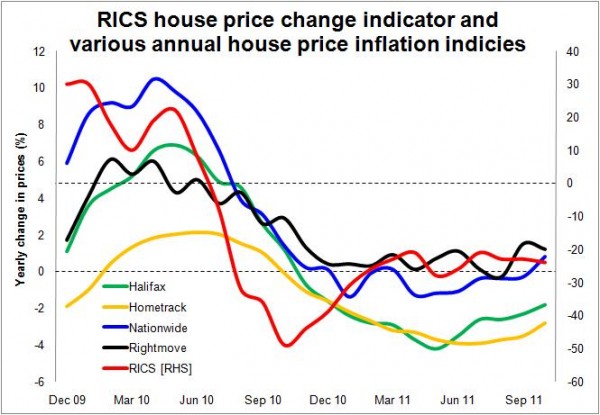Things may look slightly better in the housing market, but I wouldn’t get too excited
The balance of the news over the past couple of weeks suggests things are getting better rather than worse. But what does it all say about the medium-term prospects of the housing market?
To recap.
Today Persimmon released a broadly positive interim management statement with the tasty nugget of a 35% increase in first-time buyer visitors over a year ago. Bovis also released its statement today which said private reservations in the 44 weeks to November 4 were up 22% on the same period last year.
Yesterday’s release of Taylor Wimpey’s interim management statement said that “the more normal seasonal pattern over the autumn period is encouraging” and that its private net reservations rate was up from 0.55 sales per outlet per week from an equivalent a year ago of 0.47.
 At the start of the month the Nationwide house price survey put annual house price growth at 0.8% – the first positive result since March.
At the start of the month the Nationwide house price survey put annual house price growth at 0.8% – the first positive result since March.
Rightmove’s recorded annual growth in the asking prices for homes was reasonably positive and Halifax and Hometrack both recorded smaller annual house price falls.
Meanwhile, findings from the surveyors’ body RICS release today could also be construed as positive on the grounds that its house price survey recorded a pick-up in new buyers and new sellers.
That is all very comforting in a world so full of uncertainty. Sadly it doesn’t really mean a great deal.
Firstly the variations between regions cloud the overall picture, so in one sense aggregated or averaged national figures are pretty meaningless.
So when you look at the RICS survey you see that while London is doing well on prices, most other regions are suffering.
More to the point any minor ups and downs – and there have been plenty over recent months – are indistinguishable from the noise you would expect to find in these types of survey.
Furthermore the ups and downs, if they are real, probably tell us more about the skittishness of the market than they do about any underlying trends.
One look at the graph probably sums up most of what you might want to know about where prices are going. They are flatlining in nominal terms and falling gently in real terms.
The truth is the housing market is broadly in stasis, waiting, if you like, for something to happen.
What should matter to those with an interest in the housing market is less what is happening now and more what is likely to drive the market over the next few months.
Here you can pick any one of a number of factors, from the negative effects of a fallout from Greece defaulting on its debt to the positive outcome if the UK Government decided to implement a mortgage guarantee scheme.
The one thing that is common about so many of the factors that might impact significantly on the housing market is the level of uncertainty that surrounds them.
So while data trainspotters such as I might be getting excited about the minor ups and downs of housing market indicators, given the enormous uncertainties, it may prove – metaphorically – to be time spent observing ripples ahead of a tsunami.
Then again it may not. Let’s hope not.